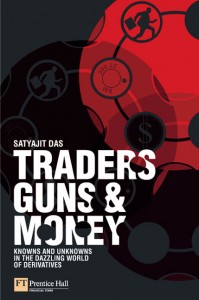Given a recent conversation and chapter 9 of Satyajit Das book traders, guns and moneys which is dealing with “credit where credit is due – fun with CDS and CDO, my aim to today is to discuss the role of derivatives and its function in mitigating credit risk between commercial banks and investment banks. Given Satyajit own words credit is the most important thing in banking industry, “it’s like a glue, it’s the stuff that holds banks together”.
Commercial banks are the very institutions which are responsibles for credit risk, their aim is to assess whether or not a borrower can repay his debts and to adjust downpayment requirement and interest rates ratio. All this business is reliable on skills and analytic capabilities that you can traditionnaly find in commercial banking. Traditionnaly, investment banks are not confortable with assessing credit risks. Principles governing credit risk assessing are always been the same since the beginning of the use of loans to finance the economy and productive investments. The method used to do such evaluation has remained the same since Rotschild began to lend a few centuries ago according to Satyajit Das.
What follows is an interpretation of chapter 9. You might want to take it with precaution.
Credit like glue is sticky – once you take the credit risk you can’t get rid of it easily. So, you have to risk until the loan is paid back or the contract finishes. That was certainly always the case before credit derivatives came along. […] The investment banks played an important role in creating derivatives that allowed the transfer of credit risk.
It is not easy to sell a loan given that you need most of the time the borrower’s approval. Derivatives are just a way – not to really sell loans from commercial banks to another investor – but to transfer credit risks without changing the owner of any given loan. In stockmarket, we speak of traders who really trade – sell and buy – real shares and bonds that they really owns AND we speak of brokers who trade shares and bonds that they don’t own properly speaking. They just need to do short selling (or short buying?) to borrow a share they didn’t own in order to bet on future evolution of share prices. Not owning the share or the bond is essential to make successful investments, even if share or bond prices are going substantially down. The link between brokers and derivatives (a derivative may be conceived in order to purchase and sell credit risk without moving loan and mortgage property) is tiny but it carries the same way of dealing with risks : you can benefit from a bet (on future evolution of stocks or bonds) getting true without carrying risks of that same bet getting false.
A derivative is also a financial bundle were several credit risks (sometimes thousands) with a lot of different levels of creditworthiness ( the assessment of whether a credit risk is good or tricky). The aim being to create a financial product where the amount of risks being carried is quite difficult to assess or guess.

2 thoughts on “Brokers and derivatives – Satyajit das, traders, guns and money, chapter 9 : how to transfer, spread and divide credit risk through derivatives”